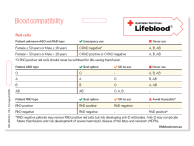Don’t have an account?
Select the donation type you’d like to make
There are over 55 antigens in the Rh system, with new antigens still being discovered.
The 5 main Rh antigens on red cells are C. c, D, E and e antigens. The D antigen is the most immunogenic and clinically important Rh antigen, followed by the c and E antigens.
Routine Rh typing of donors and patients only tests for the presence of the D antigen. An individual with D antigen on their red cells is considered D positive. Conversely, an absence of the D antigen means that the individual will be D negative.
If a D negative individual is exposed to even a small amount of D positive cells either through transfusion or pregnancy, they can form the antibody anti-D.
- All Rh alloantibodies including anti-D. anti-C, anti-E, anti-e and anti-c, should be considered clinically significant and potentially capable of causing haemolytic transfusion reactions.
- Most Rh antibodies are primarily IgG and they are clinically significant due to their ability to cross the placenta and cause haemolytic disease of the fetus and newborn (HDFN) with severe cases seen with anti-D and anti-c and mild to moderate cases with anti-C, anti-E and anti-e.
Rh inheritance patterns
The Rh blood group system is attributable to two genes, RHD and RHCE, which are located on chromosome 1.
The RHD gene is dominant, so the D antigen will be expressed whenever the RHD gene is present, even though the gene may have only been inherited from one parent. A person is D positive whenever a RHD gene is inherited, and D negative if they haven't inherited the gene.
Slight differences, also known as polymorphisms, exist in the RHD gene. These polymorphisms result in weak D or partial D variant phenotypes, which somewhat complicates the inheritance pattern of the D antigen. Learn more on Rh phenotypes here.
RHD gene inheritance patterns
Below are the possible D phenotypes children may express according to the combination of parental D phenotypes determined by RHD gene inheritance.
| Parental D phenotype | Child's D phenotype |
|---|---|
| Positive and Positive | Positive or Negative |
| Positive and Negative | Positive or Negative |
| Negative and Negative | Negative |
Updated April 2025



